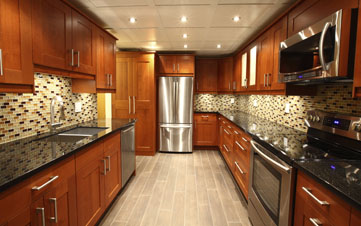Remodeling Projects That Pay Off and Look Great
These renovations will give your home a fresh look — and they provide a decent return on investment, too.
Are you planning to spruce up your home? Whether you’re getting ready to sell your house or you’re just tired of having a dated kitchen or bathroom, it’s important to make smart, cost-effective choices when you renovate.
If you expect to stay put for a while, even a minor remodeling project can enhance your enjoyment of the space. And if you plan to put your house on the market soon, you can give it a competitive edge by painting, updating lighting fixtures and appliances, or even refreshing a bathroom or two before listing it.
Tips for sellers
If you’re making upgrades in anticipation of putting your home up for sale, do your research first to make sure it’s money well spent. After all, not all fix-it projects yield the same return on investment — and why plunk money down on a project that won’t provide a reasonable return when you sell?

Sign up for Kiplinger’s Free E-Newsletters
Profit and prosper with the best of expert advice on investing, taxes, retirement, personal finance and more - straight to your e-mail.
Profit and prosper with the best of expert advice - straight to your e-mail.
“If you have a house that looks old or worn, your potential buyers will discount their offer by their estimate of what it will take to bring it up to par,” says Mari Adam, a certified financial planner in Boca Raton, Florida. “But while it’s great to make your house look fresher and up to date, you don’t want to over-improve it or do idiosyncratic projects that won’t appeal to a potential buyer.”
One way to help get the most value for your remodeling buck is to consult an experienced local real estate agent. A local agent understands the market, knows what’s selling and what’s not, and is familiar with the homes that will compete against yours. He or she knows what it will take to present your home in the best possible light and can make suggestions of projects to improve its marketability.
This is important too because competition in some markets is tight. And the National Association of Realtors estimates home sales will rise by 9% year-over-year in 2025.
Another valuable resource is the annual Cost vs. Value (CVV) report from Zonda, a housing data and consultancy firm. This report analyzes 23 common home-renovation projects to determine how much value those projects retain at resale.
Results of the CVV report are often surprising. For example, many homeowners believe that a kitchen or bath remodel will provide the most return on their investment. But the 2024 CVV report, released in April 2024 and based on 2023 data, found that a garage door replacement was the top-performing project. With an average cost of $4,513 and an $8,751 resale value, a homeowner completing that project will recoup a whopping 194% of the cost.
The second- and third-ranked remodeling projects on the 2024 list were a steel entry-door replacement and installation of manufactured stone veneer, which returned 188% and 153% of their cost, respectively. It’s no coincidence that all three of the top-performing projects this year are exterior projects that help to improve a home’s curb appeal.
“A buyer’s first impression of a house is super strong,” says Clay DeKorne, chief editor of Zonda’s JLC group. “When buyers drive up to a house that looks really shabby on the exterior, they form an impression that directly affects how much they want to pay for it. The interior may be wonderful, but they have to overcome the impressions they form about the outside.”
Curb appeal is an example of the old adage, “You don’t get a second chance to make a first impression.” Prospective buyers assume that if a house is well maintained, with an updated exterior, fresh paint, flowers and manicured landscaping, that the owner has been equally attentive to routine maintenance of the rest of the house, DeKorne says.
The CVV also indicates which home-improvement projects don’t deliver value. An upscale bathroom addition, for example — a project with an average cost of $107,477 — returns just 32.6% of that cost at sale, and an upscale primary suite addition, with an average cost of $339,513, has a return of just 23.9%.
That’s why home sellers need to carefully assess their planned projects to make sure they don’t spend money they won’t get back upon the sale of their homes. The full Cost vs. Value report breaks down the average cost and resale value for projects by region as well as nationwide.
Making it your own

Even if you’re not planning to sell your house soon, the CVV report can help guide you if you’re on a budget; many of the projects with the highest return on investment are also among the ones with the lowest costs. And because you don’t have to worry about making renovations that appeal to a wide range of potential home buyers, you can choose upgrades that suit your tastes.
“People love to renovate their kitchens and bathrooms because that’s when they can put their mark on a house,” says DeKorne. “All of the selections — the countertops, flooring, cabinets, fixtures — are personal, and the value you get is the enjoyment of living in the space you created.”
You can spend tens of thousands of dollars to create a kitchen you love, a place where you’ll spend countless hours dining, entertaining or socializing with friends and family. But if the buyer of your house doesn’t like the ornate cherry cabinets you selected and prefers a bright white kitchen, then that kitchen will have no value to the buyer.
Homeowners planning to stay for a while should feel free to personalize their space, choosing designs and finishes that make their house a home, rather than keeping it neutral in an attempt to appeal to a broader audience of potential home buyers.
Debby Belt, a senior associate at Hammond Residential Real Estate in Chestnut Hill, Massachusetts, says clients often ask her whether a certain renovation is worthwhile. “When I’m asked that question, the number one thing I say is, ‘Will you enjoy it?’ ” she says. “You can’t think of the future because by the time you sell your house, the styles might be different.”
Below are four remodeling projects among the top 10 from the CVV report that recoup the highest percentage of their cost at resale. We chose them not only because are they decent investments, but also because they can make your living space more enjoyable if you plan to stick around for a while. (Or, in the case of putting energy-efficient appliances in your kitchen or adding new siding — which can also improve energy efficiency — the projects can save you some money on utility bills in the long run.)
Plus, all these renovations have an average cost of less than $30,000, and some may run considerably less, allowing you to rejuvenate your home without breaking the bank.
Give your kitchen a facelift

A minor kitchen remodel is one of only two interior projects that are among the CVV report’s top 10 performers (the other is a midrange bath remodel; see below). The kitchen remodel costs an average of $27,492, with a resale value of $26,406 and 96.1% of the cost recouped.
Zonda based these numbers on the following specifications:
- A functional but dated 200-square-foot kitchen
- 30 linear feet of cabinetry and countertops
- Leaving cabinet boxes in place and replacing fronts with new shaker-style wood panels and drawer fronts, including new hardware
- Replacing a cooktop/oven range and slide-in refrigerator with new energy-efficient models
- Replacing laminate countertops
- Installing a mid-price sink and faucet
- Adding new resilient flooring
- Painting walls, trim and ceiling
This project, which requires no demolition except for removal of the counters and flooring, can be completed in four weeks, according to Lee Bardin, owner of Expert Renovation Team in Newton, Massachusetts, who has 30 years of design-build experience.
While it’s a great way to refresh a dated kitchen economically, Bardin warns that old cabinet boxes might be in poor shape, with stains or water damage — and that will be visible as soon as you open the doors. An alternative to refacing is to spray paint the cabinets, drawers and doors with multiple coats of lacquer finish. Bardin says the finished look is great and the cost is less than that of refacing.
Upgrade to fiber-cement siding
Replacing existing siding with new fiber-cement siding has an average job cost of $20,619, a resale value of $18,230 and a return on investment of 88.4%. Zonda based these numbers on the following specifications:
- Replacing 1,250 square feet of existing siding with new fiber-cement siding (factory primed and factory painted)
- Installing trim pieces, using either fiber-cement boards or cellular PVC
- Ensuring a continuous water-resistive barrier, such as a house wrap, beneath the siding
Fiber-cement siding, while more expensive than vinyl, is durable and long-lasting, and it performs better in moist environments, according to Elizabeth Gomez, co-owner of Bridge City Contracting in Battle Ground, Wash. The most important component of the installation process, which takes about three to five days for a 1,250-square-foot siding job, is the wrap that goes under the siding because it weatherizes the house and protects it from moisture issues such as dry rot and black mold, she says.
If your existing siding is in good shape and you’re primarily interested in boosting curb appeal, one way to re-side a house cost-effectively is to do only the front. That’s what Danielle Kilian did in 2021, when she installed fiber-cement siding on the front of her 1,546-square-foot home in Vancouver, Washington, at a total cost of about $13,000, including painting and a new front door. “
The rest of the siding was in good-enough condition, and we did the front to update the look of the house,” says Kilian, events director for the Building Industry Association of Clark County. “The front is what is seen by neighbors and by ourselves when we come home. So that was the most important piece for us, and we were able to do it in an affordable way.”
Build a deck

The addition of a wood deck has an average cost of $17,615, a resale value of $14,596 and a return of 82.9%. These costs are based on the following specifications:
- Adding a 16-by-20-foot deck, using pressure-treated joists (which are more resistant to rot and insects), supported by 4-by-4-inch posts anchored to concrete piers
- Installing pressure-treated deck boards in a simple linear pattern
- Including a built-in bench and planter of the same decking material
- Including stairs and a complete railing system using pressure-treated wood posts, railings and balusters
The construction of a 16-by-20-foot wood deck takes less than a week, according to Michael Ebner, owner of Back to Nature Decks in Oreland, Pennsylvania. Once the deck is completed, he recommends sealing it and re-sealing every year or two to preserve it.
Ebner notes that about 80% of his clients opt for a composite deck instead of wood, although the price is higher — an average $24,206 for a 16-by-20-foot deck with similar specifications as the wood deck described above, according to the CVV report. The composite will last longer, Ebner says — good for 20 to 30 years with no maintenance. So if you’re planning to stay in your house for more than 10 years, he says the composite is “a no-brainer.”
One tip Ebner has for homeowners who want a deck is to go big. “A 16-by-20-foot deck is decent, but with all the amenities people have now — grills and furniture and a fire pit — think about extending the budget a bit to make it bigger. You will always fill it.” The incremental price of building a slightly larger deck is not substantial, he says, adding about $40 to $45 per square foot to the cost.
Update a bathroom
A midrange bathroom remodel comes with an average job cost of $25,251, a resale value of $18,613 and a return on investment of 73.7%. These statistics are based on a bathroom remodel with the following specifications:
- Updating an existing 5-by-7-foot bathroom
- Replacing all fixtures, including a 30-by-60-inch porcelain-on-steel tub with a 4-by-4-inch ceramic tile surround
- Installing a new single-lever temperature and pressure-balanced shower control, a standard white toilet, a solid-surface vanity counter with an integrated sink, a recessed medicine cabinet with a light, a ceramic tile floor, and vinyl wallpaper
Bardin says that what starts as a simple bathroom remodel may end up being more comprehensive if the plumbing or electrical systems need to be updated as well. He says this project typically takes about eight weeks because multiple subcontractors are involved and, in his jurisdiction, seven inspections are needed along the way.
Bardin has two tips for home-owners planning a bathroom remodel. First, for the sink, he recommends a single-hole faucet, not the type with a spout and two handles. He says the single position has fewer problems, lasts longer and is easier to clean. Second, if a tub/shower is being installed, he says it’s critical that it be no deeper than 14 inches because it’s challenging for a homeowner or guest to step over anything higher, especially with wet feet. He suggests that anyone who wants a soaking tub install it in the primary bath, not a secondary bath that children and guests will be using.
Updating a bathroom can add tremendous value to a home. Real estate agent Debby Belt first tried to sell an expanded ranch home in Chestnut Hill, Massachusetts, with dated bathrooms, although it had a beautiful new kitchen. The offers she received were low, so Belt suggested that the owner take the house off the market and refresh three bathrooms, which Belt described as “livable, but dreary.” After she re-listed the home, it sold for $140,000 more than it would have before the bathroom facelifts, ultimately closing in February 2022 for $2.6 million.
Note: This item first appeared in Kiplinger Personal Finance Magazine, a monthly, trustworthy source of advice and guidance. Subscribe to help you make more money and keep more of the money you make here.
Related content
Get Kiplinger Today newsletter — free
Profit and prosper with the best of Kiplinger's advice on investing, taxes, retirement, personal finance and much more. Delivered daily. Enter your email in the box and click Sign Me Up.
Robyn A. Friedman is an award-winning freelance business journalist who has over two decades of experience covering real estate and personal finance topics. A former real estate attorney, Robyn is now a columnist for The Wall Street Journal and a regular contributor to the Boston Globe, Multi-Housing News, the South Florida Sun-Sentinel and other publications. She has shared her expertise as a guest on the Wall Street Journal’s Your Money Briefing podcast and on Cheddar. An avid reader and yoga practitioner, Robyn currently lives in South Florida.
-
 Ten Cheapest Places To Live in Florida
Ten Cheapest Places To Live in FloridaProperty Tax Make your Florida vacation spot daily living — these counties have the lowest property tax bills in the state.
By Kate Schubel
-
 I'm 50 and my home is worth $5 million. Can I retire now?
I'm 50 and my home is worth $5 million. Can I retire now?It may be oh-so tempting to cash out your upscale home and leave work for good. But should you? We ask the experts.
By Maurie Backman
-
 I'm 50 and My Home Is Worth $5 Million. Can I Retire Now?
I'm 50 and My Home Is Worth $5 Million. Can I Retire Now?It may be oh-so tempting to cash out your upscale home and leave work for good. But should you? We ask the experts.
By Maurie Backman
-
 Bouncing Back: New Tunes for Millennials Trying to Make It
Bouncing Back: New Tunes for Millennials Trying to Make ItAdele's mournful melodies kick off this generation's financial playlist, but with the right plan, Millennials can finish strong.
By Alvina Lo
-
 Fired Up By the Masters and RBC Heritage? See These Homes for Sale By Golf Courses
Fired Up By the Masters and RBC Heritage? See These Homes for Sale By Golf CoursesFive homes for sale near golf courses, for people who can't get enough of the tour.
By Alexandra Svokos
-
 Retire in Malta for Quiet Coastal Perfection
Retire in Malta for Quiet Coastal PerfectionSeemingly remote yet easily accessible to other points in Europe, sunny Malta offers paths to citizenship and residency for families and retirees.
By Drew Limsky
-
 Three Simple Ways to Live Greener This Earth Day
Three Simple Ways to Live Greener This Earth DayCelebrate Earth Day with three simple, impactful habits — save energy, go green at home and give back to nature.
By Choncé Maddox
-
 How Baby Boomers and Gen Xers Are Redefining Retirement Living
How Baby Boomers and Gen Xers Are Redefining Retirement LivingBoth generations need to embrace change and leverage real estate as a dynamic asset in their retirement planning. Here's how financial advisers can help, too.
By David Conti, CPRC
-
 Best Places for LGBTQ People to Retire Abroad
Best Places for LGBTQ People to Retire AbroadLGBTQ people can safely retire abroad, but they must know a country’s laws and level of support — going beyond the usual retirement considerations.
By Drew Limsky
-
 6 Luxury Waterfront Homes for Sale Around the US
6 Luxury Waterfront Homes for Sale Around the USFrom private peninsulas to lakes, bayous and beyond, Kiplinger's "Listed" series brings you another selection of dream homes for sale on the waterfront.
By Charlotte Gorbold